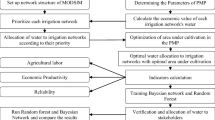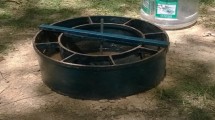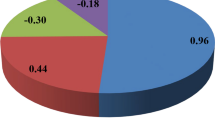Abstract
Accurate design, appropriate management, and knowledge of relationships between the parameters affecting on the performance of a surface irrigation system are the factors which play an effective role in increasing the efficiency of these systems. If parameters such as advance distance can be well estimated per specified flow rate, the volume of infiltrated water can be estimated, thereby preventing water loss and enhancing irrigation efficiency to a great extent. In the present study evaluated the accuracy of data-driven methods Random Forest (RF), Artificial Neural Networks (ANN), Adaptive Neuro Fuzzy Inference System (ANFIS), and M5 Model Tree and common numerical methods such as the Full hydrodynamic and Zero-inertia model (using SIRMOD software) and Zero-inertial model (using WinSRFR software) to predict the advance distance in furrow irrigation. To this end, seven series of data resulting from the evaluation of furrow irrigation system in various regions were collected. Each series included 12 input parameters of furrow length (L), furrow geometrical cross-section coefficients (\(\sigma_{1} ,\sigma_{2}\)), furrow hydraulic cross-section coefficients (\(\rho_{1} ,\rho_{2}\)), inflow rate (Q), Maning’s coefficient (n), field slope (\(S_{0}\)), cut-off time \((T_{\text{cutoff}} )\), final infiltration rate (\(f_{0}\)), and the infiltration parameters of the Kostiakov equation (a and k). Comparison of the results showed that all the data-driven methods managed to estimate the advance distance of the wetting front in the furrow with higher accuracy than the numerical methods. From among these, the ANFIS model had the highest accuracy (RMSE = 1.842 m, MAE = 1.305 m) in estimating the advance distance in the furrow.







Similar content being viewed by others
References
Abbasi F, Shooshtari MM, Feyen J (2003) Evaluation of various surface irrigation numerical simulation models. J Irrig Drain Eng 129(3):208–213. https://doi.org/10.1061/(ASCE)0733-9437(2003)129:3(208)
Bautista E, Clemmens AJ, Strelkoff TS, Schlegel J (2009) Modern analysis of surface irrigation systems with Win SRFR. Agr Water Manage 96:1146–1154. https://doi.org/10.1016/j.agwat.2009.03.007
Bautista E, Strelkoff TS, Schlegel JL (2012) Current developments in software for surface irrigation analysis: WinSRFR 4/SRFR 5 world environmental and water resources congress: crossing boundaries. ASCE, 2128–2137. 10.1061/9780784412312.213
Breiman L (2001) Random forests. J Mach Learn 45(1):5–32. https://doi.org/10.1023/A:1010933404324
Caudill M (1987) Neural networks primer, part I. AI Expert 2(12):46–52. https://dl.acm.org/citation.cfm?id=38295
Chow VT (1959) Open channel hydraulics. McGraw-Hill, New York
Clemmens AJ, Dedrick AR, Strand RJ (1995) BASIN—a computer program for the design of level-basin irrigation systems. version 2.0. WCL Report 19. USDA–ARS
Dayhoff JE (1990) Neural network principles. Prentice-Hall Press, New York
Elliott RL, Walker WR (1982) Field evaluation of furrow infiltration and advance function. Trans ASCE 25(2):396–400
Elliott RL, Walker WR, Skogerboe GV (1982) Zero-inertia modeling of furrow irrigation advance. J Irrig Drain Div 108(3):179–195
Esfandiari M, Maheshwari BL (2001) Field evaluation of furrow irrigation models. J Agr Eng Res 79:459–479
Ebrahimian H, Liaghat A (2011) Field evaluation of various mathematical models for furrow and border irrigation systems. Soil Water Res 6(2):91–101. https://doi.org/10.17221/34/2010-SWR
Furman A (2008) Modeling coupled surface-subsurface flow processes: a review. Vadose Zone J 7(2):741–756. https://doi.org/10.2136/vzj2007.0065
Haznedar B, Kalinli A (2016) Training ANFIS Using Genetic Algorithm for Dynamic Systems Identification. Int J Intell Syst Appl Eng 4:44–47. https://doi.org/10.18201/ijisae.266053
Hornbuckle, JW, Christen EW, Faulkner RD (2005) Use of SIRMOD as a quasi real time surface irrigation decision support system. In: Zerger A, Argent RM (eds) MODSIM 2005. International congress on modelling and simulation. Modelling and Simulation Society of Australia and New Zealand, pp 217–223
Jang JSR (1993) ANFIS: adaptive-network—based fuzzy inference system. IEEE Trans Syst Man Cybern 23(3):665–684
Jurriens M, Zerihun D, Boonstra J, Feyen J (2001) SURDEV: surface irrigation software, design, operation and evaluation of basin, border, and furrow irrigation. International institute for land reclamation and improvement, ILRI, Wageningen
Khanna T (1990) Foundations of neural networks reading. Addison-Wesley, Massachusetts, MA
King BA, Bjorneberg DL, Trout TJ, Mateos L, Araujo DF, Costa RN (2015) Estimation of furrow irrigation sediment loss using an artificial neural network. J Irrig Drain Eng 142(1):04015031–04015038. https://doi.org/10.1061/(ASCE)IR.1943-4774.0000932
Kisi O, Haktanir T, Ardiclioglu M, Ozturk O, Yalcin E, Uludag S (2009) Adaptive neuro-fuzzy computing technique for suspended sediment estimation. Adv Eng Softw 40:438–444. https://doi.org/10.1016/j.advengsoft.2008.06.004
Latif M, Mahmood S (2004) Field measurement and simulation of advance rate for continuous and surge irrigated furrows in Pakistan. Irrig And Drain 53:437–447. https://doi.org/10.1002/ird.140
Mahdizadeh Khasraghi M, GholamiSefidkouhi MA, Valipour M (2015) Simulation of open- and closed—end border irrigation systems using SIRMOD. Arch Agron Soil Sci 61(7):929–941. https://doi.org/10.1080/03650340.2014.981163
Mattar MA, Alazba AA, El-Abedin TZ (2015) Forecasting furrow irrigation infiltration using artificial neural networks. Agric Water Manag 148:63–71. https://doi.org/10.1016/j.agwat.2014.09.015
Mehana HM, EL-Bagoury KF, Hussein MM, EI-Gindy AM (2009) Validation of surface irrigation model sirmod under clay loam soil conditions in Egypt. J Irrig Drain Eng 26(3):1299–1317
Moravejalahkami B, Mostafazadeh-fard B, Heidarpour M, Abbasi F (2012) The effects of different inflow hydrograph shapes on furrow irrigation fertigation. Biosyst Eng 111(2):186–194. https://doi.org/10.1016/j.biosystemseng.2011.11.011
Najafi G, Ghobadian B, Tavakoli T, Buttsworth DR, Yusaf TF, Faizollahnejad M (2009) Performance and exhaust emissions of a gasoline engine with ethanol blended gasoline fuels using artificial neural network. Appl Energy 86(5):630–639. https://doi.org/10.1016/j.apenergy.2008.09.017
Oweis TY (1983) Surge flow furrow irrigation hydraulics with zero inertia. Doctoral Thesis presented to Utah State University, Logan, UT, pp 621
Oweis TY, Walker WR (1990) Zero- inertia model for surge flow furrow irrigation. Irrig Sci 11:131–136. https://doi.org/10.1007/BF00189449
Quinlan JR (1992) Learning with continuous classes. In: Proceeding of Australian joint conference on artificial intelligence, 16–18 November, pp 343–348
Sablani SS, Ramaswamy HS, Sreekanth S, Prasher SO (1997) Neural network modeling of heat transfer to liquid particle mixture in cans subjected to end-over-end processing. Food Res Int 30(2):105–116. https://doi.org/10.1016/S0963-9969(97)00029-X
Sayari S, Rahimpour M, Zounemat-Kermani M (2017) Numerical modeling based on a finite element method for simulation of flow in furrow irrigation. Paddy Water Environ 15(4):879–887. https://doi.org/10.1007/s10333-017-0599-6
Shaalan K, Riad M, Amer A, Baraka H (1999) Speculative work in neural network forecasting: an application to Egyptian cotton production. Egypt Comput J 27(1):58–79
Souza F (1981) Nonlinear hydrodynamic model of furrow irrigation, Ph.D. thesis, University of California, Davis, California, USA
Strelkoff T (1969) One-dimensional equation of open channel flow. J Hydraul Div 95:861–876
Strelkoff TS (1992) EQSWP: extended unsteady—flow double—sweep equation slover. J Hydraul Eng 118(5):735–742
Strelkoff T, Katapodes ND (1977) Border irrigation hydraulics with zero inertia. J Irrig Drain Div 103(IR3):325–342
Strelkoff TS, Clemmens AJ, Schmidt BV, Slosky EJ (1996) Border: a design and management aid for sloping border irrigation systems. WCL Report, 21
Suparta W, Alhasa KM (2016) Modeling of tropospheric delays using ANFIS. Springer International Publishing
Svetnik V, Liaw A, Tong C, Culberson J, Sheridan RP, Feuston BP (2003) Random forest: a classification and regression tool for compound classification and QSAR modeling. J Chem Inf Com Sci 43(6):1947–1958. https://doi.org/10.1021/ci034160g
Taki M, Ajabshirchi Y, Ranjbar SF, Rohani A, Matlooi M (2016) Heat transfer and MLP neural network models to predict inside environment and energy lost in a semi-solar greenhouse. Energ Buildings 110(1):314–329. https://doi.org/10.1016/j.enbuild.2015.11.010
Taki M, Rohani A, Soheili-Fard F, Abdeshahi A (2018) Assessment of energy consumption and modeling of output energy for wheat production by neural network (MLP and RBF) and Gaussian process regression (GPR) models. J Clean Prod 172:3028–3041. https://doi.org/10.1016/j.jclepro.2017.11.107
Valipour M (2012) Comparison of surface irrigation simulation models: full Hydrodynamic, Zero Inertia, Kinematic Wave. J Agric Sci 4(12):68–74. https://doi.org/10.5539/jas.v4n12p68
Valipour M, Montazar AA (2012a) An evaluation of SWDC and WinSRFR models to optimize of infiltration parameters in Furrow irrigation. AM J Sci Res 69:128–142
Valipour M, Montazar AA (2012b) Optimize of all effective infiltration parameters in furrow irrigation using Visual Basic and genetic algorithm programming. Austral J Basic Appl Sci 6(6):132–137
Verikas A, Gelzinis A, Bacauskiene M (2011) Mining data with random forests: a survey and results of new tests. Pattern Recognit 44:330–349. https://doi.org/10.1016/j.patcog.2010.08.011
Walker WR (1993) SIRMOD, a surface irrigation model. Utah State University, Department of Biological and Irrigation Engineering, Logan
Walker WR (2003) Surface irrigation simulation, evaluation and design. User Guide and Technical Documentation. Utah State University, Logan, Utah, pp 145
Walker WR, Humphreys AS (1983) Kinematic wave furrow irrigation model. J Irrig Drain Div 109(4):377–392
Walker WR, Lee TS (1981) Kinematic-wave approximation of surged furrow advance. InASAE Winter Meeting Paper No. 81-2544
Walker WR, Skogerboe GV (1987) Surface irrigation: theory and practice. prentice-hall Inc, Englewood Cliffs
Witten IH, Frank E (2005) Data mining: practical machine learning tools and techniques with java implementations. Morgan Kaufmann, San Francisco
Yassin MA, Alazba AA, Mattar MA (2016) A new predictive model for furrow irrigation infiltration using gene expression programming. Comput Electron Agric 122:168–175. https://doi.org/10.1016/j.compag.2016.01.035
Zounemat-Kermani M (2012) Hourly predictive Levenberg–Marquardt ANN and multi linear regression models for predicting of dew point temperature. Meteorol Atmos Phys 117(3–4):181–192. https://doi.org/10.1007/s00703-012-0192-x
Author information
Authors and Affiliations
Corresponding author
Ethics declarations
Conflict of interest
The authors declare that they have no conflict of interest.
Additional information
Communicated by G. Merkley.
Publisher's Note
Springer Nature remains neutral with regard to jurisdictional claims in published maps and institutional affiliations.
Rights and permissions
About this article
Cite this article
Golestani Kermani, S., Sayari, S., Kisi, O. et al. Comparing data driven models versus numerical models in simulation of waterfront advance in furrow irrigation. Irrig Sci 37, 547–560 (2019). https://doi.org/10.1007/s00271-019-00635-5
Received:
Accepted:
Published:
Issue Date:
DOI: https://doi.org/10.1007/s00271-019-00635-5




